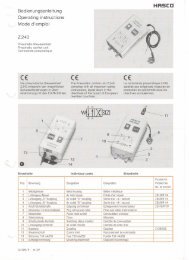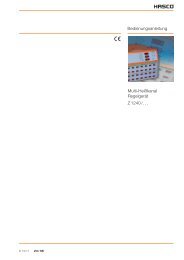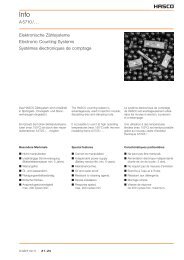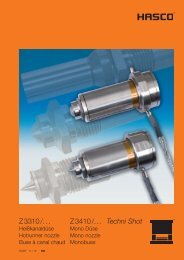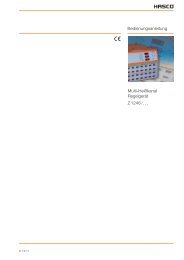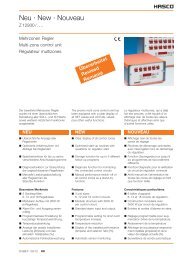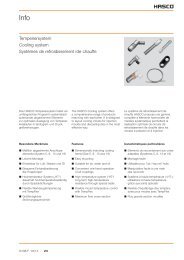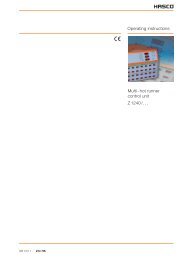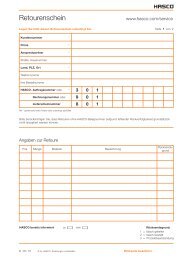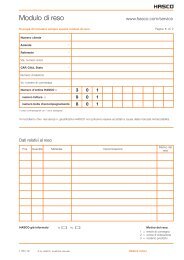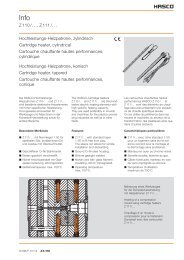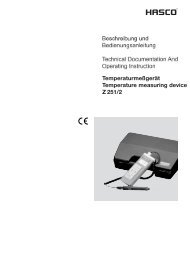Z1721 DGBF.qxd - Hasco
Z1721 DGBF.qxd - Hasco
Z1721 DGBF.qxd - Hasco
You also want an ePaper? Increase the reach of your titles
YUMPU automatically turns print PDFs into web optimized ePapers that Google loves.
Neu · New · Nouveau<br />
Z 1721 / …<br />
Mitnehmer<br />
Frictional puller<br />
Taquet d’entraînement<br />
Der neue <strong>Hasco</strong>-Mitnehmer Z 1721/ …<br />
ist eine Weiterentwicklung des praxiserprobten<br />
Z 172 / … .<br />
Besondere Merkmale<br />
Vorzugsweise einsetzbar in<br />
3-Platten-Werkzeugen<br />
In 4 Durchmessern verfügbar<br />
( 10,12,16 und 20)<br />
Automatische Zentrierung der<br />
Kunststoffhülse<br />
Einstellung der Reibkraft mit Z 32 / …<br />
Patent angemeldet<br />
1<br />
D/GB/F 08/03<br />
The new <strong>Hasco</strong> frictional puller<br />
Z 1721/ … is a further development<br />
of the proven Z 172 / … .<br />
Features<br />
Primarily used in 3-plate moulds<br />
Available in 4 diameters<br />
( 10,12,16 and 20)<br />
Automatic centring of the plastic<br />
sleeve<br />
Setting of friction with Z 32 / …<br />
Patented<br />
Le nouveau taquet d’entraînement<br />
Z 1721 /… est un nouveau développement<br />
du modèle Z 172 / … éprouvé<br />
dans la pratique.<br />
Caractéristiques particulières<br />
Utilisable de préférence dans les<br />
moules à 3 plaques<br />
Disponible en 4 diamètres<br />
( 10, 12, 16 et 20)<br />
Centrage automatique de la douille<br />
plastique<br />
Réglage de la force de friction avec<br />
Z32/…<br />
Fait l’objet d’une demande de brevet
Funktion<br />
2<br />
Der Mitnehmer Z 1721/ … überträgt<br />
durch Reibung zwischen der Kunststoffhülse<br />
(2) und einer Bohrungswand<br />
axial Kräfte.<br />
Die Reibungskraft kann durch das<br />
Druckstück (3) mittels der Zylinderschraube<br />
(4) eingestellt und den<br />
Erfordernissen angepasst werden.<br />
Durch die Halbkugeln an der Aufnahme<br />
(1) und dem Druckstück (3) wird eine<br />
gleichmäßige Ausdehnung der<br />
Kunststoffhülse gewährleistet.<br />
Der Mitnehmer kann zum Einbau am<br />
Schaft bearbeitet (siehe Bild 2) oder bei<br />
Bedarf seitlich mit einer Schraube fixiert<br />
werden (siehe Bild 1)<br />
Dieses verblüffend einfache, erprobte<br />
Prinzip ist z. B. vorteilhaft zum Ziehen<br />
von Werkzeugplatten einzusetzen.<br />
Ebenso ist dieses Normteil als<br />
„Bremse“ zu verwenden, wenn z. B.<br />
Bewegungen von Bauelementen<br />
verzögert werden sollen oder als „Stoßdämpfer“,<br />
um hartes Zusammenfahren<br />
von Platten zu dämpfen.<br />
Z 1721 / …<br />
Mitnehmer<br />
Frictional puller<br />
Taquet d’entraînement<br />
Function<br />
1 4 2 3<br />
SW 1<br />
The frictional puller Z 1721/ … transmits<br />
axial forces through friction between<br />
the plastic sleeve (2) and bore wall.<br />
The friction force can be adjusted by<br />
means of the pressure pin (3) using the<br />
cylinder screw (4) to suit prevailing<br />
requirements.<br />
An even expansion of the plastic<br />
sleeve is guaranteed due to the half<br />
spheres on the shank (1) and the<br />
thrust piece (3).<br />
The puller can be modified for fitting on<br />
the shank (see figure 2) or, if required, it<br />
can be fixed in place using a screw on<br />
the side (see figure 1).<br />
b 2<br />
This remarkably simple, tried-andtested<br />
principle can be used to great<br />
advantage for pulling mould plates, for<br />
example. Similarly, this standard part<br />
can also be used as a "brake", for<br />
instance if movements of components<br />
are to be delayed, or as a "shock<br />
absorber" in order to prevent violent<br />
plate collisions.<br />
Polyamid (PA)<br />
10 Z32/...<br />
Fonctionnement<br />
Bearbeitungszugabe<br />
Machining Allowance<br />
Surépaisser<br />
Le taquet d’entraînement Z 1721/ …<br />
transmet des forces axiales par friction<br />
entre la douille plastique (2) et un orifice<br />
dans le mur.<br />
La force de friction peut être réglée par<br />
l’élément de pression (3) au moyen de<br />
la vis cylindrique (4) et adaptée aux<br />
exigences posées.<br />
Les deux hémisphères de la réception<br />
(1) et l’élément de pression (3) garantissent<br />
une expansion régulière de la douille<br />
plastique.<br />
Le taquet d’entraînement peut être<br />
usiné pour son montage dans le couloir<br />
(cf. ill. 2) ou, en cas de besoin, être fixé<br />
de manière latérale au moyen d’une vis<br />
(cf. ill. 1).<br />
Ce principe extrêmement simple et<br />
éprouvé est p. ex. recommandé pour<br />
l’emboutissage de plaques d’outils. De<br />
même, cet élément « normé » peut être<br />
utilisé comme « frein » lorsque p. ex.<br />
des mouvements d’éléments doivent<br />
être temporisés ou bien comme<br />
« amortisseur », pour amortir justement<br />
la réunion trop brutale de plaques.<br />
Z32/… SW1 b2 b1 l4 l2 l1 d1 d2 Nr. / No. EDV-Nr.<br />
4x16 2,5 3,5 11 17 27 56 12 10 Z 1721 / 10 2001224<br />
5x22 3 4 15 22 36 75 16 12 Z 1721 / 12 2001225<br />
6x30 4 5,5 19 27 36 85 20 16 Z 1721 / 16 2001226<br />
8x25 5 5,5 24 36 46 109 25 20 Z 1721 / 20 2001227<br />
HASCO-Normalien GmbH + Co KG · D-58505 Lüdenscheid · Tel. +49 2351 9570 · Fax +49 2351 957237 · www.hasco.com · info@hasco.com<br />
08 03 1 3 22 / No. 010456<br />
© by HASCO D-58505 Lüdenscheid<br />
Printed in Germany<br />
Gedruckt auf chlorfrei gebleichtem Papier<br />
Printed on chlorine-free bleached paper<br />
Imprimé sur papier blanchi sans chlore<br />
Änderungen vorbehalten<br />
Alterations reserved<br />
Sous réserve de modification



